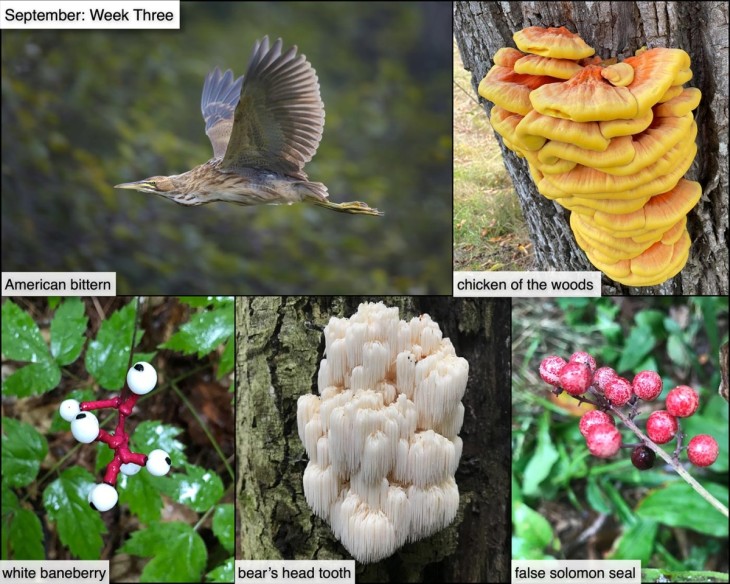The early fall temperatures, migrating birds, and abundant displays of colorful fungi and berries make this week an especially nice one to be out in the woods. Tig Tillinghast photographed this American bittern, perhaps on a break from migration, flying over a local wetlands. Also called “thunder pumpers” (if you’ve ever had one vocalize right behind you in a marsh, you know why), these beautiful birds nest in freshwater marshes where they hunt frogs, fish, and other small prey. They’re incredibly well camouflaged; when hiding, they stick up their bills and show the checkered markings on their necks, which makes them well-nigh impossible to distinguish from surrounding marsh grasses.
Meghan McCarthy McPhaul encountered this vibrant specimen of chicken of the woods, also called sulfur shelf fungi, on a walk near her home. With a meaty texture and lemony taste, these fungi are a favorite of foragers. However, Timothy Baroni, in his excellent field guide, Mushrooms of the Northeastern United States and Canada, has this warning: “If you drink alcohol, do not eat this fungus if you found it on black locust or a conifer – it is known to cause vomiting.” Most of the time, however, we see chicken of the woods growing on native hardwoods (in this case, the host tree was an ash). There is a related, also edible, species, “white chicken of the woods,” Laetiporus cincinnatus, that has white instead of bright yellow pores, and grows at the base of trees. As ever: never eat a wild mushroom unless you 100% know what it is.
False solomon’s-seal (multiple species) is a common wildflower that often appears in shady, moist woodlands and on the edges of wetlands. If you’re lucky enough to get there before the birds and rodents, you may be able to see its berries now. We found this specimen on a trail near the Northern Woodlands office.
During that same trail walk, we also discovered bear’s head tooth – which, incidentally, seems like a really weird choice of name for a fungus that resembles a frozen waterfall. A member of the Hericium genus and fungal cousin of the better-known, less lumpy, bearded tooth (lion’s mane), it grows on both living and dead hardwood trees.
Finally, autumn wouldn’t be complete without a shout-out to the season’s creepiest plant, white baneberry, aka doll’s eyes, which observes you unblinkingly from the underbrush. The plants are poisonous to humans, especially the berries, which can cause cardiac arrest. Birds, however, seem able to digest the berries just fine and help to spread the seeds. The birds are probably attracted by the high contrast combination of white berries and dark pink pedicels (an example of “fruit flagging”).
What have you noticed in the woods this week? Submit a recent photo for possible inclusion in our monthly online Reader Photo Gallery.


